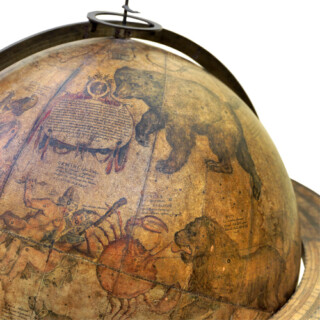The Tarots de Etteilla
Tarots de Etteilla
[ANONYMOUS after Jean-Baptiste ALLIETTE]
Paris,
B.P. Grimaud & Cie,
[c1890].
78 chromolithograph playing cards, with blue pattern to versos, housed in modern case.
118 by 65mm (4.75 by 2.5 inches).
20732
To scale:
notes:
notes:
The Maker
Jean-Baptiste Alliette, who went by the pseudonym of Etteilla, was a French occultist and tarot-researcher who published his first book on the mystical subject while working as a seed merchant. 'Manière de se récréer avec le jeu de cartes nommées tarots' (1783-85) is still today considered the standard reference work on the subject of tarot cartomancy. Three years later Alliette formed the 'Société des Interprètes du Livre de Thot' and soon after the 'Nouvell...
Jean-Baptiste Alliette, who went by the pseudonym of Etteilla, was a French occultist and tarot-researcher who published his first book on the mystical subject while working as a seed merchant. 'Manière de se récréer avec le jeu de cartes nommées tarots' (1783-85) is still today considered the standard reference work on the subject of tarot cartomancy. Three years later Alliette formed the 'Société des Interprètes du Livre de Thot' and soon after the 'Nouvell...
The Maker
Jean-Baptiste Alliette, who went by the pseudonym of Etteilla, was a French occultist and tarot-researcher who published his first book on the mystical subject while working as a seed merchant. 'Manière de se récréer avec le jeu de cartes nommées tarots' (1783-85) is still today considered the standard reference work on the subject of tarot cartomancy. Three years later Alliette formed the 'Société des Interprètes du Livre de Thot' and soon after the 'Nouvelle Ecole de Magie'.
In 1789, he published his own deck of tarot cards which differed from the traditional Marseilles deck that had formed the body of much of his research, and which was widely disseminated in various editions throughout the following centuries. The present edition was published by B.P. Grimaud & Cie., which had been founded in 1848 as a small playing card factory in Paris, producing decks on a range of themes and subjects. The firm continued to prosper throughout the subsequent century, and in 1962 was bought by a larger company, Ducale-France Cartes. It continues today as part of the Cartamundi Group.
The Cards
The 78 cards in the present deck replicate the figures, scenes and designs found on the original Etteilla cards, but with smaller illustrations leaving room for captions and numbers to be written in the outer border. Using decks such as this, practitioners of cartomancy formulate questions about the past, present or future, and then select a card unseen to interpret for their answer.
Some cards seem fairly direct, such as 15 - Maladie, 21 - Dissension, and 80 - L'Amour, while the meaning of others is open to interpretation, 16 - Jugement, for example. Many of the cards have two, seemingly opposing, options illustrated and labelled on them: 6 - Nuit / Jour, 25 - Etranger / Nouvelle, 44- Le Passé / Avenir. Also found illustrating many cards are the Minor Arcana, or the suit cards in a tarot deck, descending from the early non-cartomantic game played in Italy from the fifteenth century. The Minor Arcana consist of wands, cups, swords and coins, associated respectively with creativity, emotions, reason and possessions. Other information given on certain cards to aid in their interpretation include the element associated with that card.
Jean-Baptiste Alliette, who went by the pseudonym of Etteilla, was a French occultist and tarot-researcher who published his first book on the mystical subject while working as a seed merchant. 'Manière de se récréer avec le jeu de cartes nommées tarots' (1783-85) is still today considered the standard reference work on the subject of tarot cartomancy. Three years later Alliette formed the 'Société des Interprètes du Livre de Thot' and soon after the 'Nouvelle Ecole de Magie'.
In 1789, he published his own deck of tarot cards which differed from the traditional Marseilles deck that had formed the body of much of his research, and which was widely disseminated in various editions throughout the following centuries. The present edition was published by B.P. Grimaud & Cie., which had been founded in 1848 as a small playing card factory in Paris, producing decks on a range of themes and subjects. The firm continued to prosper throughout the subsequent century, and in 1962 was bought by a larger company, Ducale-France Cartes. It continues today as part of the Cartamundi Group.
The Cards
The 78 cards in the present deck replicate the figures, scenes and designs found on the original Etteilla cards, but with smaller illustrations leaving room for captions and numbers to be written in the outer border. Using decks such as this, practitioners of cartomancy formulate questions about the past, present or future, and then select a card unseen to interpret for their answer.
Some cards seem fairly direct, such as 15 - Maladie, 21 - Dissension, and 80 - L'Amour, while the meaning of others is open to interpretation, 16 - Jugement, for example. Many of the cards have two, seemingly opposing, options illustrated and labelled on them: 6 - Nuit / Jour, 25 - Etranger / Nouvelle, 44- Le Passé / Avenir. Also found illustrating many cards are the Minor Arcana, or the suit cards in a tarot deck, descending from the early non-cartomantic game played in Italy from the fifteenth century. The Minor Arcana consist of wands, cups, swords and coins, associated respectively with creativity, emotions, reason and possessions. Other information given on certain cards to aid in their interpretation include the element associated with that card.
bibliography:
bibliography:
provenance:
provenance:







![[ANONYMOUS after Jean-Baptiste ALLIETTE] Tarots de Etteilla](https://omega.crouchrarebooks.com/wp-content/uploads/2025/03/20732_1H.jpg)
![[ANONYMOUS after Jean-Baptiste ALLIETTE] Tarots de Etteilla](https://omega.crouchrarebooks.com/wp-content/uploads/2025/03/20732_2H.jpg)
![[ANONYMOUS after Jean-Baptiste ALLIETTE] Tarots de Etteilla](https://omega.crouchrarebooks.com/wp-content/uploads/2025/03/20732_3H.jpg)
![[ANONYMOUS after Jean-Baptiste ALLIETTE] Tarots de Etteilla](https://omega.crouchrarebooks.com/wp-content/uploads/2025/03/20732_4H.jpg)
